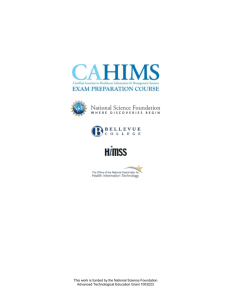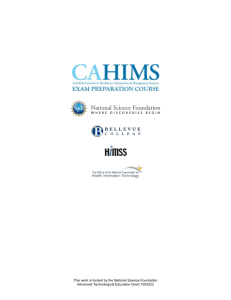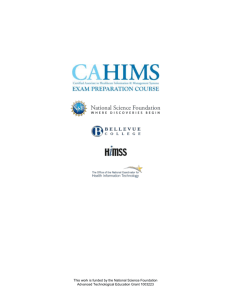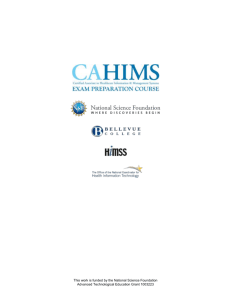2.2-Assessment-Key
advertisement
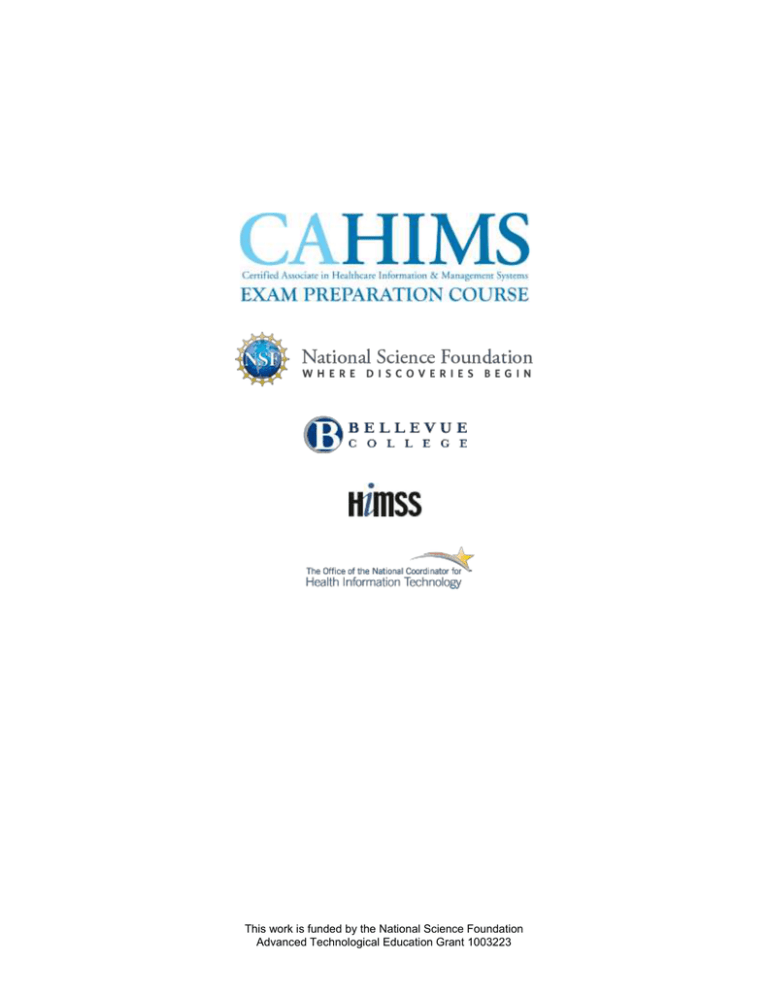
This work is funded by the National Science Foundation Advanced Technological Education Grant 1003223 The CAHIMS Exam Preparation Course and the CAHIMS exam are the result of collaboration between the Life Science Informatics Center at Bellevue College and the Healthcare Information and Management Systems Society (HIMSS). Significant content found in the CAHIMS Exam Preparation Course stems from the Office of the National Coordinator for Health Information Technology. Creation of the CAHIMS Exam Preparation Course and the CAHIMS exam was made possible through support from the National Science Foundation (NSF). Curriculum Team: Margaret Schulte, DBA Michèle Royer, PhD Nathan Savage, MLIS This work is funded by the National Science Foundation Advanced Technological Education Grant 1003223 Section 2 - Technology Environment Lesson 2.2 - Electronic Health and Medical Records Assessment Questions Answer Key Lectures 3 & 4 1. Which of the following, according to the IOM, is a software element of an EHR? *a. Patient support b. Software c. Hardware Answer: a. Patient support is a software element of an EHR? Lecture(s)/Slide(s): 4/3 2. Which of the following is one of the four key components of any EHR system? a. Provides mobility for healthcare workers *b. Provides “longitudinal health data” on individuals c. Provides secure access by sacrificing efficiency Answer: b. Provides “longitudinal health data” on individuals. Other key components include: a) Provides immediate, yet secure, electronic access; b) enhances quality, safety and efficiency of patient care; c) makes health care more efficient Lecture(s)/Slide(s): 3/7 3. Most EHR systems today are based on what kind of computer model? a. Hardware-software *b. Client-server c. Hosted Answer: b. Most EHR systems today are based on client-server model. Lecture(s)/Slide(s): 3/14 4. What are three things to consider when purchasing an EHR server? *a. Reliability, performance, scalability b. Size of the unit, performance, power consumption c. Client-Server, Service Requester, client requests This work is funded by the National Science Foundation Advanced Technological Education Grant 1003223 Page 1 Answer: a. Reliability, performance, scalability are three things to consider when purchasing an EHR server. Lecture(s)/Slide(s): 4/8 5. Name three types of servers you may find in a typical EHR system? a. Hardware, RAM, Dell *b. Configuration, terminal, VPN c. Application, Database, Citrix d. Internal, external, hosted Answer: b. Application, Database, Citrix, or Terminal are three types of severs you may find in a typical EHR system. Lecture(s)/Slide(s): 4/2 6. Software can be defined as: a. The nuts and bolts that make things work. b. The physical components of servers. *c. A collection of computer programs and related data that provide the instructions telling a computer what to do. d. A collection of computers and devices connected by communications channels that facilitates communications among users and allows users to share resources with other users. Answer: c. Software is a collection of computer programs and related data that provide the instructions telling a computer what to do. Lecture(s)/Slide(s): 3/11 7. Hardware can be defined as: *a The physical components that make things work. b. Data needed to tell the computer what to do and how to behave. c. Fast, low cost PC systems that permeate the workplace often less than $500 each. d. A computer designed to efficiently run server applications. Answer: a. Hardware is the physical components that make things work. Lecture(s)/Slide(s): 3/11 8. True or False: Server applications and client applications can exist on the same physical device. This work is funded by the National Science Foundation Advanced Technological Education Grant 1003223 Page 2 *a. True b. False Answer: a. True. Although installing server applications onto dedicated server hardware usually increases efficiency and reliability of the application, installation of both server and client applications onto one device could be warranted or even encouraged in some cases, particularly in smaller environments. Lecture(s)/Slide(s): 3/16 Lecture 1 9. A friend asks you how she can access and control her medical information electronically. Which of the electronic record systems listed below would you direct her to? a. Electronic Health Record b. Electronic Medical Record *c. Personal Health Record d. Pharmacy Health Record Answer: c. Personal Health Record Lecture(s)/Slide(s): 1/3 10. Which of the following is NOT true about the paper medical record? a. Can be easily destroyed b. Can be used for one task at a time c. Allows for duplication of information *d. Permits easy tracking of those who access it Answer: d. Permits easy tracking of those who access it Lecture(s)/Slide(s): 1/11 11. “An electronic record of patient health information containing care received in all health facilities” is the definition of *a. an Electronic Health Record. b. an Electronic Medical Record. c. a Personal Health Record. d. a Healthcare Information Record. Answer: a. an Electronic Health Record. This work is funded by the National Science Foundation Advanced Technological Education Grant 1003223 Page 3 Lecture(s)/Slide(s): 1/10 12. A friend of a patient asks the nurse if the patient is HIV positive. If the nurse provides this information, what is he or she guilty of? a. Violating information security b. Information by consent *c. Breach of confidentiality d. Nothing; this is not illegal Answer: c. Breach of confidentiality Lecture(s)/Slide(s): 1/26 13. Which of the following does not contribute to identifying the functionality of the EHR for an organization? a. Type of setting (e.g. inpatient, ambulatory) and type of services b. Population served by the provider and type of services c. Type of services provided and population served *d. Type of setting, population served and services provided assist in defining the functionality needed for the provider Answer: d. Type of setting, population served and services provided assist in defining the functionality needed for the provider Lecture(s)/Slide(s): 1/5 This work is funded by the National Science Foundation Advanced Technological Education Grant 1003223 Page 4
